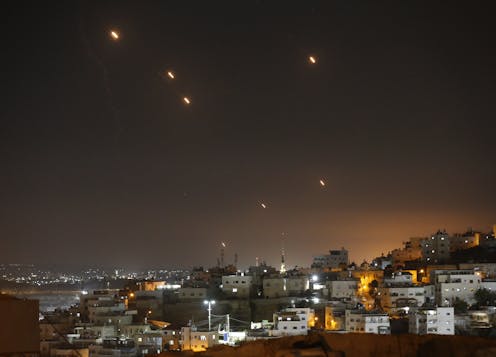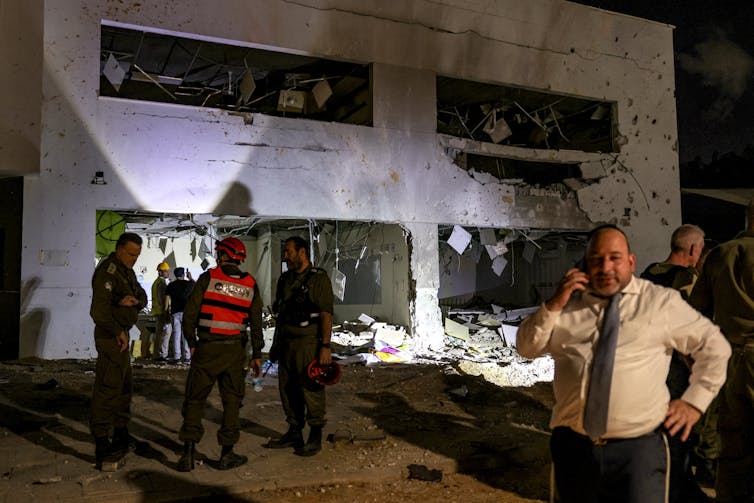Iran’s strikes on Israel are the latest sign that the conflict in the Middle East is spiraling, pres
A US counterterrorism expert explains the dynamics between Israel, Iran, Hezbollah and Hamas – and why Hezbollah presents new risks for the US and other places globally.

Iran fired at least 180 ballistic missiles at Israel on Oct. 1, 2024, amplifying tensions in the Middle East that are increasingly marked by “escalation after escalation,” as United Nations Secretary General Antonio Guterres put it.
Iran’s attacks – which Israel largely deterred with its Iron Dome missile defense system, along with help from nearby U.S. naval destroyers – followed Israel’s killing of Hassan Nasrallah, the longtime leader of the Tehran-backed Lebanese militant group Hezbollah, on Sept. 27.
Hezbollah has been sending rockets into northern Israel since the start of the Gaza war, which began after Hamas and other militants invaded Israel on Oct. 7, 2023, and killed nearly 1,200 people. Hezbollah’s rocket attacks have displaced around 70,000 people from their homes in northern Israel.
Amy Lieberman, a politics and society editor at the Conversation U.S., spoke with counterterrorism expert Javed Ali to better understand the complex history and dynamics that are fueling the intensifying conflict in the Middle East.

How much more dangerous has the Middle East become in recent weeks?
The Middle East is in much more volatile situation than it was even a year ago. This conflict has expanded far outside of fighting primarily between Israel and Hamas.
Now, Israel and Hezbollah have a conflict that has developed over the past year that appears more dangerous than the Israel-Hamas one. This involves the use of Israeli special operations units, which have operated clandestinely in Lebanon in small groups since November 2023. In addition, Israel has been accused by Hezbollah of conducting unconventional warfare operations – like the exploding walkie-talkies and pagers – and launched hundreds of air and missile strikes in Lebanon over the past few weeks. The combination of these operations has destroyed Hezbollah’s weapons caches and military infrastructure and killed several senior leaders in the group, including Hassan Nasrallah.
The human costs of these attacks is significant, as more than 1,000 people in Lebanon have died. Among this total, it is unclear how many of the dead or wounded are actually Hezbollah fighters.
Israel and Hezbollah last had a direct war in 2006, which lasted 34 days and killed over 1,500 people between Lebanese civilians and Hezbollah fighters. Since then, Israel and Hezbollah have been in a shadow war – but not with the same kind of intensity and daily pattern that we have seen in the post-Oct. 7 landscape.
Now, the conflict has the potential to widen well outside the region, and even globally.
What does Iran have to do with the conflict between Israel and Hamas and Hezbollah?
Iran has said it fired the missiles into Israel as retaliation for attacks on Hezbollah, Hamas and the Iranian military.
A coalition of groups and organizations has now been labeled as Iran’s “Axis of Resistance.” Iran’s Supreme Leader, Ayatollah Khameini, and senior military commanders in the Islamic Revolutionary Guards Corps, or the IRGC, have issued unifying guidance to all the different elements, whether it is Hamas in the Gaza Strip, the Houthi rebels in Yemen, Hezbollah in Lebanon, or Shia militias in Iraq and Syria.
Before Oct. 7, 2023, all of these groups were ideologically opposed to Israel, to a degree. But they were also fighting their own conflicts and were not rallying around supporting Hamas. Now, they have all become more active around a common goal of destroying Israel.
Iran and Hezbollah, in particular, have a deep relationship, dating back to the Iranian Revolution in 1979 and the creation of the Islamic Republic of Iran.
In 1982, Israel invaded southern Lebanon in order to thwart cross-border attacks the Palestinian Liberation Organization and other Palestinian groups were launching into Israel. The newly formed Iranian IRGC sent advisers and trainers to southern Lebanon to work with like-minded Lebanese Shiite militants who were already fighting in Lebanon’s civil war. They wanted to fight against the Israeli military and elements of the multinational force comprised of U.S., French and other Western troops that were originally sent as peacekeepers to put an end to the fighting.
How does Hezbollah’s history help explain its operations today?
The relationships between these Iranian experts and Lebanese militants during Lebanon’s 15-year civil war led to the formation of Hezbollah as a small, clandestine group in 1982.
During the following few years, Hezbollah launched a brutal campaign of terrorist attacks against U.S., French and other Western interests in Lebanon. The group, then known as Islamic Jihad, first attacked the U.S. embassy in Beirut on April 18, 1983. That attack killed 52 Lebanese and American embassy employees. However, at the time, U.S. intelligence personnel and other security experts were not clear who was responsible for the embassy bombing. And given this lack of understanding and insight on Hezbollah as an emerging terrorist threat, the group aimed even higher later in 1983.
Following the embassy attack, Hezbollah carried out the October 1983 Marine barracks bombing that killed 241 U.S. service personnel. Before the 9/11 attacks, this was the biggest single act of international terrorism against the U.S.
Hezbollah was also responsible for the kidnapping and murder of American citizens, including William Buckley, the CIA station chief for Beirut. And it carried out airplane hijackings, include the infamous TWA 847 incident in 1985, in which a U.S. Navy diver was murdered.
So, Hezbollah has a long history of regional and global terrorism.
Within Lebanon, Hezbollah is a kind of parallel government to Lebanon. The Lebanese government has allowed Hezbollah to be this state within a state, but they don’t collaborate on military operations. Currently, the Lebanese military is not responding to Israel’s attacks on Lebanon. This shows how dominant of a force Hezbollah has become.
How damaging are Israel’s attacks on Hezbollah?
Hezbollah has clearly taken losses in fighters, but Hezbollah is a far bigger group than Hamas and operates on a much bigger physical territory across Lebanon.
It has far more inventory of advanced weapons than Hamas ever did, and a large fighting force that includes 40,000 to 50,000 regular forces organized into a conventional military structure. It also has 150,000 to 200,000 rockets, drones and missiles of varying range. It operates a dangerous global terrorist unit known as the External Security Organization that has attacked Israeli and Jewish interests in the 1990s in Argentina and Jewish tourists in 2012 in Bulgaria.
The degree to which Israel has degraded Hezbollah’s capabilities over the past few weeks is unclear. But based on the volume and intensity of Israeli operations over this time, a conservative estimate of at least 10% to 15% of Hezbollah’s capacity seems plausible, and the actual amount may be even higher – presenting a serious challenge to Hezbollah’s long-term viability.
What security risks does this evolving conflict present for the US?
Looking at how Hezbollah demonstrated these capabilities over a 40-year stretch of time, and based now on how Israel has hit the militant group, it would not be a stretch to speculate that Hezbollah has ordered or is considering some kind of terrorist attack far outside the region – similar to what the group did in Argentina in 1992 and 1994. What that plot would like look, how many people would be involved, and the possible target of any such attack are not clear.
Hezbollah’s leaders have said that they blame Israel for the attacks on it. About a week before Nasrallah’s death, he said that Israel’s exploding pager and walkie-talkie operations in Lebanon were a “declaration of war” and the “the enemy had crossed all red lines.”
Since then, Hezbollah has remained defiant, in spite of the significant losses the group has sustained by Israel these past few weeks. Questions also remain about how Hezbollah’s leadership will likewise hold the U.S. responsible for Israel’s actions. And if so, would that mean a return to the type of terrorism that Hezbollah inflicted on U.S. interests in the region in the 1980s? As recent events have shown, the world is facing a dangerous and volatile security environment in the Middle East.
Javed Ali does not work for, consult, own shares in or receive funding from any company or organization that would benefit from this article, and has disclosed no relevant affiliations beyond their academic appointment.
Read These Next
What’s at stake in Trump’s executive order aiming to curb state-level AI regulation
In the absence of comprehensive federal AI regulation, states have stepped in. The Trump administration,…
The Bible says little about Jesus’ childhood – but that didn’t stop medieval Christians from enjoyin
Legends about Jesus’ early years that circulated in medieval Europe often drew on apocryphal texts.
Sleep problems and depression can be a vicious cycle, especially during pregnancy − here’s why it’s
Inadequate sleep can have negative downstream effects on everyday cognitive functioning and mental health,…





